Exploring the Red Line Metro Station in Dubai
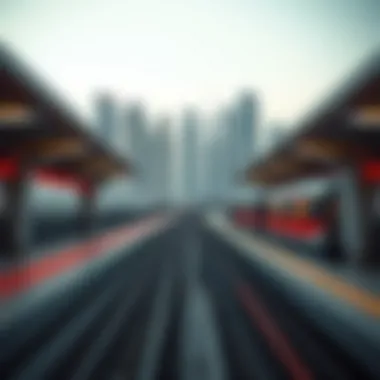
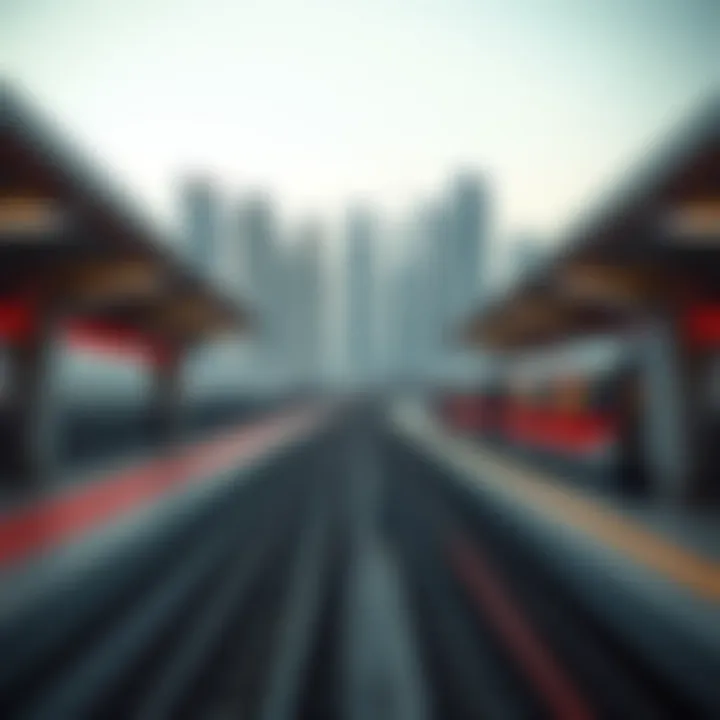
Intro
The Red Line Metro Station in Dubai stands as a modern emblem of urban transportation, weaving its way through a city that has rapidly evolved into a bustling metropolis. As you navigate through the various facets of Dubai's real estate, it's crucial to grasp how this transportation network shapes the urban fabric and impacts property markets.
In essence, the Red Line Metro does more than alleviate traffic congestion; it functions as a critical infrastructure that boosts the accessibility of numerous neighborhoods. From the flashy skyscrapers of Dubai Marina to the cozy corners of Al Quoz, the station connects people to places, underpinning the aspirations of investors, homebuyers, and commuters alike.
Moreover, understanding the relationship between the Red Line and the real estate sector opens doors to insightful discussions about investment potential and emerging trends in one of the world's most dynamic cities. In the sections that follow, we'll dive into current market insights and investment opportunities that emerge from this vibrant intertwining of transportation and urban living.
The Importance of the Red Line Metro Station in Dubai
The Red Line Metro Station holds a central position in Dubai’s urban landscape, acting as both a physical connector and a catalyst for growth within the bustling city. This metro line isn’t just about getting from point A to point B; it represents a shift in the way residents and visitors experience mobility, accessibility, and city life. As Dubai continues to expand, the Red Line's contribution cannot be understated. It serves as a vital artery, facilitating easier commutes and fostering a livable environment in which people can thrive.
Historical Context and Development
The Red Line, inaugurated in 2010, was the first metro line introduced in Dubai. Its conception aligns with Dubai's ambitious vision to modernize and enhance its public transportation infrastructure, which had previously relied heavily on cars. The historical context of this initiative is rooted in the need to address urban challenges such as traffic congestion and pollution. With Dubai's rapid population growth, developing a robust public transport system became essential. The Red Line was crafted not just with present needs in mind but with future urban scenarios, ensuring it can accommodate evolving demographic trends and economic shifts.
Architectural Features of the Station
Design Elements
The design of the Red Line Metro Station is striking and functional, blending aesthetics with utility. One of the standout features is its futuristic, flowing structure that mimics the fluidity of the desert landscape. By incorporating curves and angular lines, the architecture transcends traditional station designs, making it a lovely sight for daily commuters.
Moreover, the open layouts allow for natural light to flood the space, creating a welcoming yet efficient environment. This practical charm serves a dual purpose, beautifying the urban fabric while promoting efficiency, an integral aspect for any successful transportation hub.
Materials Used
When it comes to materials, the stations utilize high-quality elements like glass and steel, enhancing both durability and visual appeal. The extensive use of glass is not merely cosmetic; it serves functional benefits such as sound insulation and energy efficiency. The steel frames provide structural integrity, ensuring that the station can withstand the region's harsh weather conditions.
This choice of materials speaks to a broader commitment to sustainability and innovation. It reflects a forward-thinking approach where the Red Line functions beyond mere transportation—it stands as a testament to Dubai’s progressive architectural landscape.
The Role of Public Transportation in Urban Planning
Public transportation plays a pivotal role in urban planning, and the Red Line Metro Station exemplifies this principle. With an efficient transit system in place, urban planners can promote higher density living, reducing urban sprawl. This, in turn, leads to a more engaging, community-focused lifestyle.
Metro stations like the Red Line are not just terminals; they are nodes around which urban life revolves. By strategically placing developments near transit hubs, planners create accessible neighborhoods that reduce reliance on cars, thus lowering carbon footprints and fostering healthier living conditions. Furthermore, ease of access to public transport often translates to enhanced property values, making the area more appealing to investors and homebuyers alike.
"Public transportation is the backbone of any urban infrastructure, shaping the patterns of city life and impacting everything from real estate to environmental sustainability."
In summary, the significance of the Red Line Metro Station extends far beyond its physical structure. It influences economic, social, and environmental aspects, making it an essential component of Dubai's vibrant urban landscape.
Economic Implications of the Red Line Metro Station
The Red Line Metro Station has emerged as a catalyst for economic growth in Dubai, interconnecting areas and enhancing the accessibility of the bustling city. By providing a reliable public transport system, it has opened doors to various investment opportunities and a noticeable uptick in property values in the vicinity. The socio-economic fabric of communities surrounding the station has transformed considerably, making it a focal point for homebuyers, businesses, and urban planners alike.
Understanding the economic implications of this metro station goes beyond mere numbers; it factors in lifestyle and the vibrancy of the community, offering insights into how urban transport systems can shape economic landscapes.
An Overview of Property Value Trends
Property values in areas adjacent to the Red Line Metro Station have seen a remarkable rise in recent years. The presence of a metro station typically signals convenience, increasing desirability among potential buyers and investors. Just a few years ago, properties within walking distance of the station were considered less attractive, but now they command premium prices. This dramatic shift illustrates the strong correlation between public transportation accessibility and real estate value.
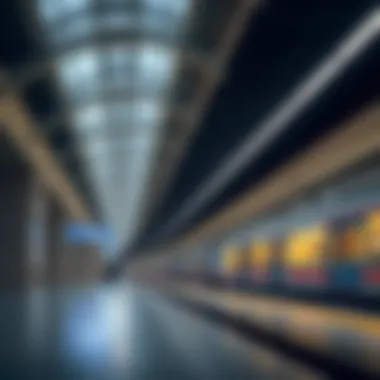
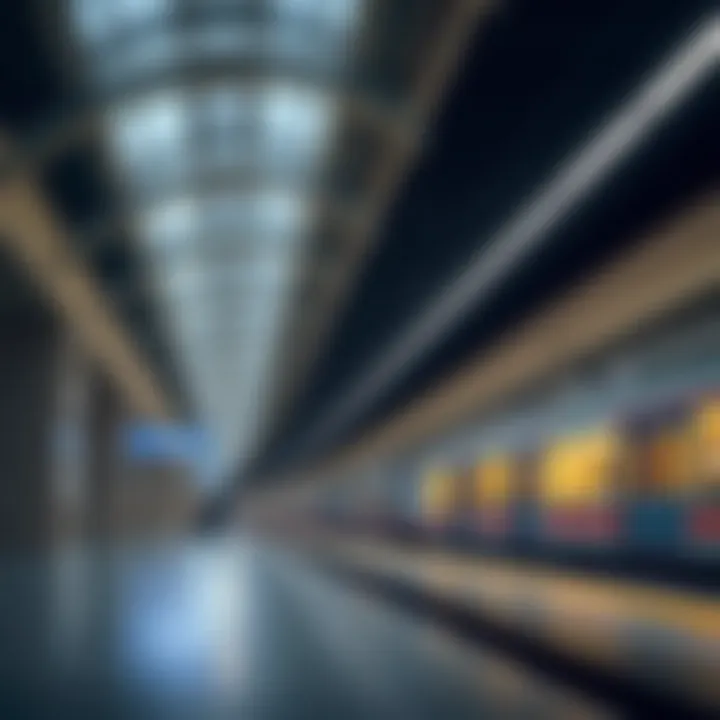
- Key Drivers of Property Value Increases:
- Improved transit access
- Enhanced local services and amenities
- Higher demand from commuters
In urban settings, the link between connectivity and real estate is comparable to fish swimming downstream; it flows naturally with the current of demand. Homebuyers are increasingly favoring locations with easy access to public transport, and as such, the Red Line's establishment has reshaped the market.
Investment Opportunities Surrounding the Station
The Red Line has created ripe conditions for investment in both residential and commercial sectors. Let's break down how this transmutation can further enrich the urban landscape.
Residential Developments
In the wake of the Red Line's inauguration, residential developments in the area have burgeoned. These new construction projects are designed with modern living in mind, incorporating concepts of space and energy efficiency, which appeal particularly to younger population groups.
- Characteristics of Residential Developments:
- Proximity to public transport
- Diverse housing options catering to different income levels
- Innovative designs and sustainable features
A distinct advantage of these residential projects is their ability to attract long-term tenants and homeowners, making them a sound investment. However, developers must be mindful of pricing; if they push too high, the affordability factor could turn potential buyers away.
Commercial Prospects
The area surrounding the Red Line Metro Station has also seen an influx of commercial businesses. Smaller shops, cafes, and larger retail outlets have sprung up, taking advantage of the foot traffic generated by commuters.
- Key Features of Commercial Prospects:
- High visibility from the station
- Catchment area of daily transit users
- Opportunities for dining, retail, and services
Given the rise in local commercial establishments, the demand for commercial leases has increased significantly. While this presents a lucrative opportunity, it also creates competition for businesses trying to carve a niche in a bustling environment.
Impact on Business Growth
Businesses situated near the Red Line Metro Station have benefited from escalated foot traffic and increased visibility. Local shops report a consistent uptick in sales since the station's opening, as commuters often grab a quick bite or conduct errands before they board.
- Business Growth Indicators:
- Local job creation
- Increase in startup ventures
- What we see is a ripple effect; as more people migrate to the area, more services are required.
This positive feedback loop enhances the overall economic vitality of the neighborhood. Essentially, the Red Line is more than just a transit system; it serves as the economic backbone of the surrounding community.
Residential Life Near the Red Line Metro Station
The Red Line Metro Station stands as a pivotal node in Dubai's urban sprawl, significantly shaping the residential landscape around it. Its well-planned routes and accessibility play a crucial role in enhancing livability. Residents in the vicinity can enjoy streamlined commuting, making it attractive not only for families but also for young professionals. The close-knit communities sprouting beyond the metro’s reach offer a blend of comfort and convenience, positioning the metro as more than just a transit solution—it's a lifeline for many.
Demographics of Nearby Communities
Demographics illuminate the diversity of cultures swarming around the Red Line Metro Station. Here, one can find a fusion of vibrant nationalities ranging from locals to expatriates forming a multicultural quilt. Families with children, professionals, and students create a dynamic mix, each contributing to the area's uniqueness. Statistics show that communities near the station often have a more youthful population, leading to a bustling atmosphere filled with energy and innovation.
This diversity further fuels local businesses, fostering shared experiences among residents. Interaction amid a multicultural setting enhances social bonds and community events, helping to create a sense of belonging and pride. Residents often participate in organizing neighborhood festivals or cultural gatherings, enriching the fabric of community life.
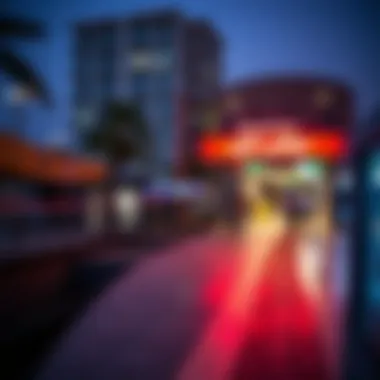
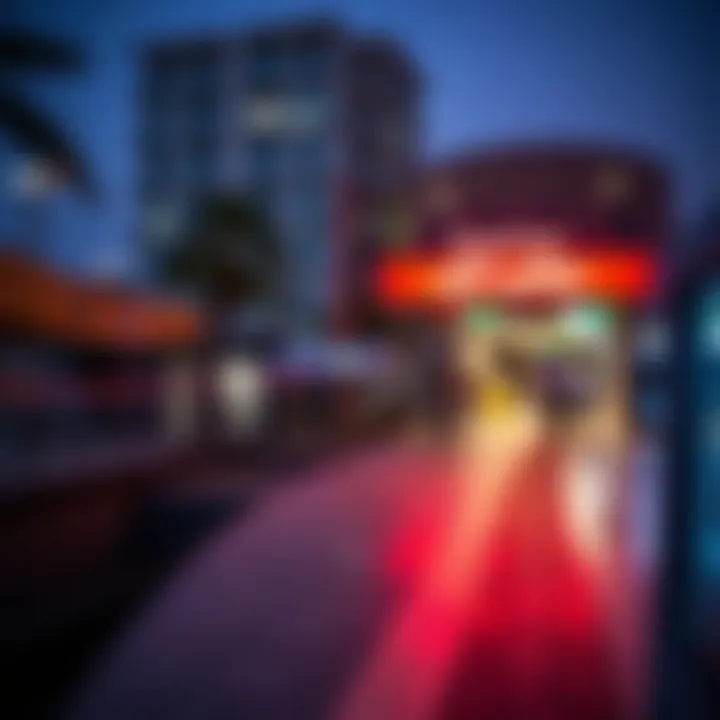
Amenities and Services
Shopping and Dining Options
The selection of shopping and dining options near the Red Line Metro Station is nothing short of impressive. The area boasts a medley of global cuisines and shopping destinations, catering to the diverse palate of its residents. Local markets coexist with international brands, creating an accessible confluence for daily needs and luxury wants alike. This mix ensures that residents can enjoy purchasing everything from fresh produce at nearby souks to high-end designer goods in sprawling malls.
What sets the dining scene apart is its affordability coupled with quality. From chic cafes to traditional eateries, residents find themselves spoiled for choice. The outdoor dining options become lively, especially in cooler months, where families and friends enjoy meals under starlit skies. However, with this popularity comes the occasional overcrowding in hotspots during peak hours, thus necessitating reservations for well-loved venues.
Health and Education Facilities
Health and education facilities near the Red Line Metro Station significantly bolster the appeal of residential life. The area features numerous well-equipped clinics and hospitals, ensuring that residents have access to quality medical care without long commutes. Many establishments employ cutting-edge technology and skilled healthcare professionals, making health an accessible priority.
Education-wise, the presence of reputable schools ranging from primary institutions to international academies makes this area particularly attractive to families with children. Parents appreciate the well-rounded curriculums and extracurricular activities available, promoting both academic growth and personal development. However, the influx of families can sometimes lead to overcrowded schools, so prospective residents might find it useful to look into enrollment processes early.
Lifestyle Considerations for Residents
Living near the Red Line doesn't just mean convenient transport—it influences a lifestyle. Short commutes translate into extra time for leisure activities, whether it’s embracing local parks, engaging in community sports, or exploring arts and cultural events. Residents report feeling more connected to the buzz of the city, unveiling opportunities to thrive in their careers and hobbies.
Security is another factor that residents often consider. The well-patrolled neighborhoods feature surveillance and community watch programs, allowing families to feel secure in their surroundings. This assurance contributes positively to the vibrant community atmosphere, where residents quickly become acquaintances, often resulting in lasting friendships.
Connectivity and Accessibility Features
The Connectivity and Accessibility Features of the Red Line Metro Station form the backbone of its role in Dubai's urban tapestry. The station is not merely a set of platforms and tracks; it embodies a vital junction that links diverse transit modes, thus shaping the mobility patterns of residents and visitors alike. In a city characterized by rapid development and sprawling urban landscapes, efficient connectivity is paramount for enhancing the overall commuter experience.
Integration with Other Transit Systems
One of the standout features of the Red Line Metro Station is its seamless integration with various transit systems. The station does not exist in isolation; rather, it acts as a conduit connecting the metro with bus services, taxis, and in some locations, even water taxis. This interconnectedness is strategic, allowing passengers to switch between transport modes without the hassle of multiple tickets or lengthy transfers. For instance, a quick five-minute walk from the station can often lead to a major bus terminal, where routes crisscross, facilitating access to different neighborhoods.
Moreover, the RTA (Roads and Transport Authority) has been keen to ensure that regular updates and expansions are made available, further enhancing the overall experience. Investing in a public transport network that aligns well with heavy traffic areas showcases a city that values its inhabitants' time and needs.
Pedestrian and Cycling Infrastructure
In an age where urban mobility is evolving, the Red Line Metro Station has kept pace by prioritizing pedestrian and cycling infrastructure. Walking paths that lead to the station are well-maintained and thoughtfully designed, allowing pedestrians to traverse them easily. Safety measures, such as crosswalks and light signals, add another layer of comfort, especially for families or those commuting during late hours.
Biking options are increasingly gaining traction, too. Bike lanes exist alongside the main thoroughfares leading to the station, promoting cycling as a viable form of transportation. More importantly, bike racks are available right at the station, allowing commuters to securely park their bicycles while they use the metro. This inclusive approach not only lessens the number of cars on the streets but also contributes to the city's eco-friendly ambitions.
Parking and Drop-off Facilities
To accommodate those who prefer to drive, the Red Line Metro Station boasts well-organized parking and drop-off facilities. Secure parking lots are available, making it convenient for commuters to leave their vehicles and catch the train. The layout is designed for efficiency; multiple entry and exit points minimize congestion, ensuring that whether you are dropping off a friend or parking your car for the day, the process is hassle-free.
The drop-off zones are strategically located close to the station entrance, providing ease of access for passengers, including those with mobility challenges. Moreover, features like digital signage that display real-time availability can guide drivers to open parking spaces, further streamlining the experience.
As more individuals opt for a blend of driving and public transport, such facilities highlight the thoughtful planning behind the Red Line Metro Station's design. They facilitate a smoother transition between travel modes and ultimately enhance the urban mobility framework in Dubai.
In summarizing the connective elements, the Red Line Metro Station stands as a centerpiece of a larger ecosystem. Its capabilities in integrating various transit systems, supporting pedestrians and cyclists, and providing accessible parking options amplify its significance in Dubai’s urban planning narrative.
Challenges and Considerations
Addressing the challenges and considerations surrounding the Red Line Metro Station is essential for understanding its impact on Dubai’s urban landscape. While this mode of transportation serves as a robust backbone for connectivity, it’s not without its hurdles. These challenges affect both daily commuters and the broader urban environment. In this section, we will delve into the crucial aspects of overcrowding and capacity issues, maintenance and operational challenges, as well as future development plans that can influence the station's effectiveness.
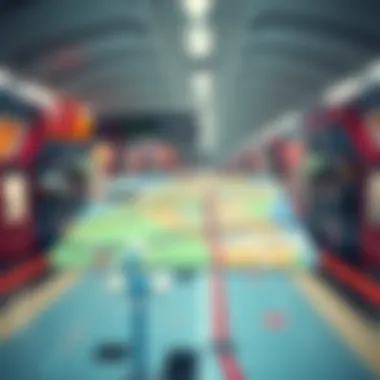
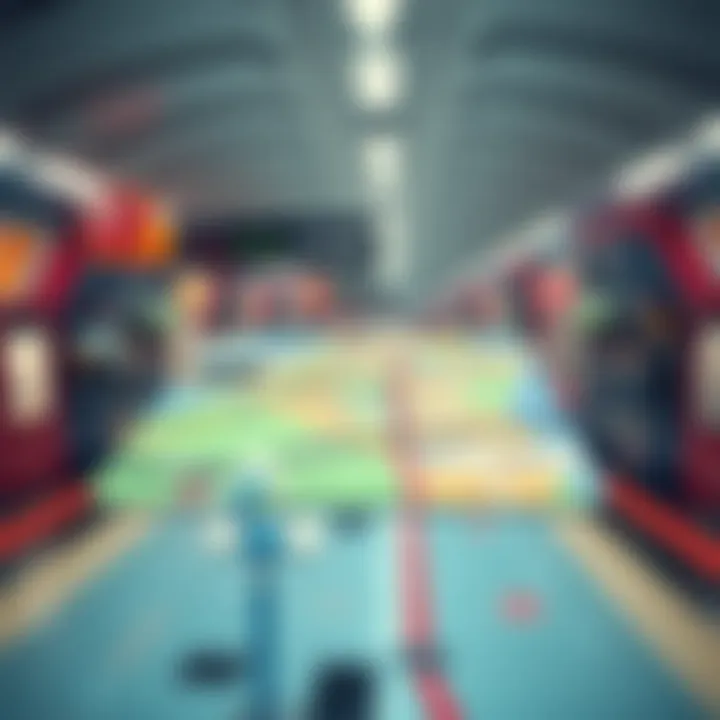
Overcrowding and Capacity Issues
Overcrowding at the Red Line Metro Station is a pressing concern, especially during peak commuting hours. With Dubai’s population steadily increasing, the number of passengers utilizing the metro correspondingly rises. To illustrate, during busy periods like the morning rush, you can often see throngs of commuters waiting to board, with space on trains increasingly at a premium. This not only affects comfort but can also lead to delays and a frustrating experience for riders.
"While the metro is designed to handle significant volumes, the reality is that certain lines, especially the Red Line, can feel overwhelmed at times."
To tackle these concerns, metro authorities need to continuously assess and possibly enhance capacity through longer trains or increased frequency. Moreover, infrastructure improvements around the station could facilitate better passenger flow, ensuring that the station remains efficient and user-friendly.
Maintenance and Operational Challenges
The importance of maintenance cannot be overstated when it comes to transit systems like the Red Line Metro. Routine upkeep is crucial for ensuring safety and reliability. Yet, the sheer scale of operations can pose challenges. From electrical issues to wear and tear on trains, these operational matters must be addressed promptly to maintain service integrity.
Furthermore, aging infrastructure can lead to increased downtime and maintenance costs. Keeping the stations clean and well-maintained is also important, as it impacts the overall perception of the metro service. Without proactive management, even a well-designed system can suffer from neglect.
Additionally, training staff to efficiently handle emergencies and passenger concerns is vital. The service team's responsiveness often shapes commuter experiences and can make all the difference during unforeseen incidents.
Future Development Plans
Thinking ahead, future development plans associated with the Red Line station could significantly enhance the urban landscape surrounding it. Various proposed projects aim to accommodate the growing population and address transit needs. These developments might include expanding the metro system with additional lines or introducing higher-capacity trains to alleviate overcrowding.
Moreover, urban planners are considering developments that integrate mixed-use properties around the station. Such projects could improve accessibility and ultimately elevate property values in surrounding neighborhoods. Connecting the metro more seamlessly with buses and cycling paths is also on the agenda, which aligns with sustainable urban growth practices this city aspires to achieve.
The Red Line Metro Station as a Cultural Landmark
The Red Line Metro Station stands not just as a transit point in Dubai’s urban tapestry, but as a cultural beacon for the city. This station isn’t just about facilitating transportation; it also embodies the spirit of innovation and growth that Dubai represents. With a unique blend of function and artistry, it ties together the narratives of the communities surrounding it, while simultaneously becoming a stage for cultural expression and interaction.
This section will explore how the artistic contributions, communal activities, and the rich experiences of visitors mark the station’s significance as a cultural landmark, making it more than just a place to catch a train.
Art and Design Installations
The aesthetic elements of the Red Line Metro Station contribute significantly to its stature as a cultural landmark. Expansive murals, sculptures, and design installations tell stories reflective of Dubai’s heritage and the diverse backgrounds of its residents. Notably, artists from various cultural backgrounds have been invited to showcase their work, making the station feel like an art gallery on the move.
Consider the vibrant mural representing the desert landscape juxtaposed with urban development, skillfully positioned in the main hall. This artwork symbolizes the transition and dynamic growth of Dubai, merging tradition with modernism.
Additionally, the architecture of the station itself is noteworthy. Featuring sleek lines and contemporary materials, the design incorporates elements of Islamic architecture while remaining functional for a busy transit hub.
"The Red Line Metro Station is more than just a travel point; it's a canvas that reflects the essence of Dubai through art and design."
Community Events and Activities
The cultural impact of the Red Line Metro extends beyond its visual offerings. The station periodically hosts community events that foster social interaction and celebrate local culture. From seasonal festivals to art exhibitions, these activities provide a platform for local artists and performers to engage with the public.
Residents and visitors alike can partake in events such as:
- Art Workshops: Opportunities for budding artists to learn skills from seasoned instructors.
- Cultural Festivals: Celebrations featuring traditional dance performances and music from around the world.
- Educational Programs: Engaging community discussions focusing on art, history, and social issues relevant to Dubai's populace.
This involvement enhances community ties and attracts visitors who wish to experience Dubai’s cultural richness firsthand.
Visitor Experiences
For many, the Red Line Metro Station is often a prelude to urban exploration. Visitors experience not just a transit system, but also a vibrant atmosphere steeped in cultural significance. The artworks and community activities are just a part of the allure; the overall experience emphasizes connectivity—not just in terms of transportation, but within the cultural landscape of Dubai.
Tourists frequently comment on how the station encapsulates the essence of their visit, highlighting both the artistic works and the bustling activity of commuters and locals.
Moreover, the station is nestled near key attractions such as the Dubai Mall and Burj Khalifa, enabling an enriching journey that blends transit with exploration. Each experience at the station offers a glimpse into the life of a multicultural city, making it a memorable stop for anyone navigating through Dubai.
As the Red Line Metro Station continues to evolve, its role as a cultural landmark will likely grow. Each interaction—be it through art, community events, or shared experiences—cements its place not just in the city’s infrastructure but in the hearts of those who pass through it.







